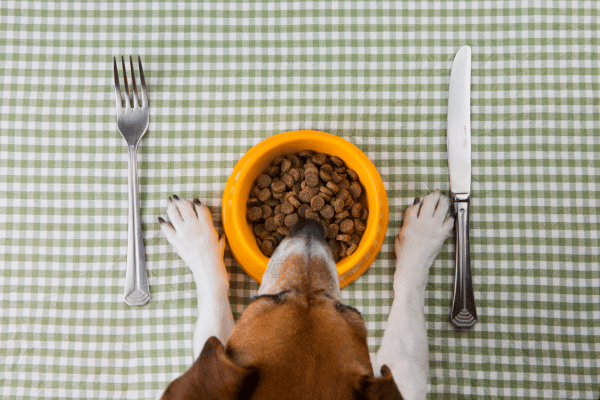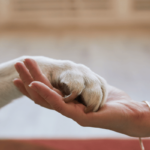Discover essential tips for a Healthy Dog Diet Plan. This guide offers invaluable insights for pet owners seeking optimal nutrition for their beloved dogs.
Essential Components of a Dog’s Diet

Understanding the basics of a dog’s nutritional needs is crucial. Dogs require a balanced blend of proteins, carbohydrates, fats, vitamins, and minerals. Proteins, the building blocks of body tissues, should be the cornerstone of their diet. Moreover, carbohydrates provide energy, while fats are vital for energy and cell structure. Importantly, a Healthy Dog Diet Plan should include a variety of these elements to ensure comprehensive health benefits.
Transitioning to a healthier diet requires careful consideration of your dog’s age, activity level, and health status. Puppies, for instance, need more calories and protein for growth. Conversely, older dogs may benefit from lower-calorie diets to maintain a healthy weight. Always consult a veterinarian before making significant changes to your dog’s diet. This ensures the Healthy Dog Diet Plan is tailored to your pet’s specific needs, promoting longevity and vitality.
Incorporating fresh, whole foods can significantly enhance your dog’s diet. Fresh vegetables and fruits, in moderation, provide essential vitamins and fiber. Lean meats like chicken or fish offer high-quality protein. However, avoid toxic foods like onions, grapes, and chocolate. Remember, a Healthy Dog Diet Plan isn’t just about what they eat, but also what they should avoid. Balancing commercial dog foods with fresh ingredients can lead to a happier, healthier pet.
Balancing Commercial and Homemade Dog Foods
While commercial dog foods offer convenience, incorporating homemade meals can boost your dog’s diet quality. Homemade meals allow control over ingredients, ensuring no harmful additives or preservatives. Start by consulting a veterinarian or a canine nutritionist to create a balanced Healthy Dog Diet Plan. This plan should complement commercial foods with homemade options, like cooked lean meats, vegetables, and grains, ensuring your dog receives all necessary nutrients without overfeeding.
Transitioning to a mixed diet of commercial and homemade foods should be gradual. Abrupt changes can upset your dog’s digestive system. Introduce new foods slowly, observing how your dog reacts. If they show signs of discomfort or allergies, consult your vet immediately. A Healthy Dog Diet Plan is about finding the right balance that suits your dog’s individual needs, ensuring they thrive on a diet that’s both nutritious and enjoyable.
Remember, not all human foods are safe for dogs. Foods like garlic, onions, and chocolate can be toxic. Research and consult professionals when adding new items to your dog’s diet. The goal of a Healthy Dog Diet Plan is to enhance your dog’s health without risking their well-being. With the right balance of commercial and homemade foods, your dog can enjoy a varied, nutritious diet that supports their overall health.
Healthy Dog Diet Plan: Supplementing Nutrients
Supplements can play a vital role in a Healthy Dog Diet Plan, especially for specific health needs. For instance, older dogs may benefit from joint supplements like glucosamine, while omega-3 fatty acids can improve coat health. However, it’s essential to consult with a veterinarian before adding any supplements to your dog’s diet. They can recommend the right type and dosage based on your dog’s individual health requirements and dietary needs.
Vitamins and minerals are also crucial in a dog’s diet. While most are present in balanced commercial diets, homemade meals might need supplementation. For example, calcium and phosphorus are essential for bone health but must be balanced correctly. A Healthy Dog Diet Plan should be well-rounded, providing all the necessary nutrients either through diet or supplements. Always prioritize quality and suitability when choosing supplements for your dog.
Probiotics and digestive enzymes can also benefit your dog’s gastrointestinal health, especially if they have digestive issues. These supplements aid in nutrient absorption and promote a healthy gut flora. Including them in a Healthy Dog Diet Plan can lead to better digestion and overall health. As with any supplement, the key is moderation and professional guidance. Tailoring supplements to your dog’s specific needs can significantly enhance their diet and well-being.
Understanding Dog Food Labels and Ingredients

Deciphering dog food labels is a critical skill for implementing a Healthy Dog Diet Plan. Look for high-quality protein sources like chicken, beef, or fish as the first ingredient. Avoid foods with excessive fillers, artificial colors, or preservatives. Understanding the ingredients and their order of appearance on the label helps in selecting the best commercial food for your dog. It’s about finding a balance between quality ingredients and your dog’s specific dietary needs.
Additionally, consider the nutritional adequacy statement on dog food labels. This statement indicates whether the food is a complete and balanced diet for a specific life stage of a dog. A Healthy Dog Diet Plan should cater to your dog’s life stage, whether they’re a puppy, adult, or senior. Each stage has different nutritional requirements, and the right food can significantly impact your dog’s health and development.
Lastly, be aware of any marketing gimmicks. Terms like gourmet or premium don’t always equate to better quality. Focus on the nutritional value and ingredient list rather than attractive packaging or marketing terms. A Healthy Dog Diet Plan is based on nutritional science, not marketing hype. By understanding what goes into your dog’s food, you can make informed decisions that contribute to their long-term health and happiness.
Monitoring Your Dog’s Health and Diet Response
Regularly monitoring your dog’s health is essential when following a Healthy Dog Diet Plan. Pay attention to their energy levels, coat condition, and overall demeanor. Changes in appetite, weight, or digestion can indicate whether their diet is working or if adjustments are needed. Regular vet check-ups are also crucial to assess your dog’s health and to make any necessary dietary changes. A proactive approach ensures your dog benefits fully from their diet.
Observing your dog’s stool is also a good indicator of their digestive health. A healthy diet should result in firm, regular stools. If you notice any drastic changes, such as diarrhea or constipation, it might be a sign to reassess their diet. A Healthy Dog Diet Plan should be adaptable, changing as needed to suit your dog’s evolving health needs. Remember, each dog is unique, and what works for one may not work for another.
Lastly, don’t hesitate to adjust the diet based on your dog’s feedback. If they’re not enjoying their meals or showing signs of food intolerance, consider alternative ingredients or formulations. A Healthy Dog Diet Plan is not just about nutrition; it’s also about enjoyment and suitability. Your dog’s enthusiastic response to their meals is a good sign that you’ve found the right balance between nutrition, taste, and health.
Exploring Variety and Moderation in Dog Diets

Variety is the spice of life, even for dogs. Introducing different foods can prevent boredom and ensure a range of nutrients. However, any changes should be gradual and monitored. A Healthy Dog Diet Plan balances variety with consistency, avoiding any digestive upsets. Rotating different proteins, vegetables, and grains can provide a spectrum of nutrients while keeping mealtime interesting for your dog. Always ensure that any new food is safe and suitable for dogs.
Moderation is key in a dog’s diet. Overfeeding, even with healthy foods, can lead to obesity and health issues. Understanding portion sizes and adjusting them according to your dog’s size, age, and activity level is crucial. A Healthy Dog Diet Plan emphasizes the quality of food as well as the right quantity. Regular exercise and portion control are essential components of maintaining your dog’s health alongside a nutritious diet.
Remember, treats should also be given in moderation. While treats are an excellent way to bond and train, they should not exceed 10% of your dog’s daily caloric intake. Choose healthy treat options that complement the Healthy Dog Diet Plan. Avoid human snacks that are high in sugar or fat. Healthy treats can include small pieces of fruits and vegetables, like carrots or apples, that are safe for dogs.
Addressing Special Dietary Needs and Allergies
Some dogs have special dietary needs or allergies that must be considered in a Healthy Dog Diet Plan. Common allergens include certain proteins, grains, and dairy products. If you suspect your dog has a food allergy, consult your veterinarian. They can help identify the allergen and suggest appropriate dietary changes. Hypoallergenic diets or limited ingredient diets can be beneficial for dogs with food sensitivities, ensuring they receive nutrition without adverse reactions.
For dogs with medical conditions like diabetes, heart disease, or kidney issues, dietary management is crucial. A Healthy Dog Diet Plan for these dogs might include specific types of proteins, limited sodium, or controlled carbohydrate levels. Always work with your veterinarian to develop a diet plan that supports your dog’s medical needs while providing balanced nutrition. Tailored diets can significantly improve the quality of life for dogs with chronic health conditions.
Lastly, consider your dog’s lifestyle and environment. Active dogs or those living in colder climates may require more calories. Conversely, indoor or less active dogs might need fewer calories to avoid weight gain. A Healthy Dog Diet Plan should be flexible, adapting to your dog’s changing lifestyle and health status. Regular assessments and adjustments ensure that your dog’s diet continues to meet their needs effectively.
Final Thoughts on a Healthy Dog Diet Plan
In conclusion, a Healthy Dog Diet Plan is a cornerstone of your dog’s overall well-being. It requires a balance of high-quality ingredients, tailored to your dog’s specific needs. Regular consultations with your veterinarian and staying informed about canine nutrition are essential. Remember, each dog is unique, and what works for one may not work for another. Always prioritize your dog’s health and happiness when making dietary decisions.
Encourage readers to share their experiences and tips on dog nutrition in the comments. This engagement not only fosters a community of informed pet owners but also provides a platform for exchanging valuable insights. Additionally, invite them to explore other sections of the DW Focus – 4 Paws and Owners blog for more information on pet care, behavior, and breed-specific advice. Engaging with the content can deepen their understanding and commitment to their pets’ health.
For further reading and resources, visit American Kennel Club’s website for comprehensive guides on dog nutrition and health. This article was informed by their expert insights, ensuring accuracy and relevance. Your feedback and interaction are invaluable to us. Please leave a comment, share your stories, or suggest topics you’d like to see covered in future articles. Together, we can create a thriving community of responsible and knowledgeable pet owners.
Preventing Obesity with Proper Diet Management
Obesity in dogs is a growing concern, making a Healthy Dog Diet Plan more crucial than ever. It’s not just about what you feed, but also how much and how often. Regular, measured meals rather than free-feeding, help prevent overeating. Pay attention to the calorie content of their food and adjust portions accordingly, especially for less active dogs. A balanced diet, combined with regular exercise, is key to maintaining a healthy weight.
Treats should be given sparingly and accounted for in the daily calorie intake. Opt for healthy, low-calorie treats that align with a Healthy Dog Diet Plan. Also, be mindful of human food scraps, which can be high in calories and unhealthy for dogs. Consistency in feeding habits and routine check-ups with your vet can help manage your dog’s weight effectively, ensuring they stay within a healthy range for their breed and size.
Monitoring your dog’s body condition score regularly is essential. This score helps you determine if your dog is underweight, overweight, or at an ideal weight. Adjust their diet and exercise routine based on this score. A Healthy Dog Diet Plan is not static; it evolves with your dog’s changing health needs. By actively managing their diet, you can prevent obesity-related health issues and promote a longer, healthier life for your pet.
Hydration: An Essential Part of Dog Diets
Hydration is often overlooked in a Healthy Dog Diet Plan. Water is essential for every bodily function, from digestion to circulation. Ensure your dog has constant access to fresh, clean water. Dehydration can lead to serious health issues, especially in hot weather or after exercise. While the water content in wet foods can contribute to hydration, it’s not a substitute for drinking water. Monitoring your dog’s water intake is as important as monitoring their food.
Signs of dehydration include lethargy, dry gums, and excessive panting. If you notice these symptoms, encourage your dog to drink water and consult a veterinarian if necessary. A Healthy Dog Diet Plan also involves being aware of your dog’s environment and activity level, as these factors influence their hydration needs. In warmer climates or during intense exercise, increase their water availability to ensure they stay adequately hydrated.
Remember, the quality of water is as important as its availability. Regularly clean your dog’s water bowl to prevent the buildup of bacteria and encourage them to drink more. Some dogs prefer running water; consider a pet water fountain if this is the case. Integrating proper hydration into your Healthy Dog Diet Plan is a simple yet effective way to boost your dog’s overall health and well-being.
Canine Nutrition Essentials: Building Blocks for a Healthy Pooch
- High-Quality Protein Sources: Essential for building and maintaining body tissues. Common sources include chicken, beef, or fish.
- Carbohydrates: Provide energy and can include ingredients like rice, barley, or vegetables.
- Fats: Vital for energy, cell structure, and the absorption of certain vitamins. Sources include fish oil and flaxseed.
- Vitamins and Minerals: Crucial for various bodily functions and overall health. Often included in commercial dog foods but may need supplementation in homemade diets.
- Water: Essential for hydration and overall health. Dogs should have constant access to fresh, clean water.
- Fiber: Important for digestive health. Sources can include certain vegetables and grains.
- Omega-3 and Omega-6 Fatty Acids: Beneficial for skin and coat health. Can be found in fish oil and certain plant oils.
- Antioxidants: These are crucial for combating oxidative stress and supporting immune health. Common sources include blueberries, carrots, and spinach.
- Probiotics: Beneficial for maintaining a healthy gut flora, probiotics can aid in digestion and nutrient absorption. They are often found in fermented foods like yogurt or can be added as supplements.
- Joint-Supporting Nutrients: Especially important for older dogs or breeds prone to joint issues. Ingredients like glucosamine and chondroitin support joint health and mobility.
Generated based on information from the following PetMD
See more: Essential Components of a Dog’s Diet.
Concluding Thoughts: Embracing a Lifelong Journey of Canine Nutrition
In summary, a Healthy Dog Diet Plan is a lifelong commitment to your dog’s health and happiness. It’s about understanding and adapting to their changing nutritional needs. Regular vet visits, staying informed, and being observant of your dog’s health are key. Remember, each dog is unique, and their diet should reflect their individual needs. Embrace this journey with love and care, and you’ll contribute significantly to your dog’s quality of life.
We encourage you to share your experiences and learn from others in our community. Your insights on dog nutrition can help fellow pet owners navigate their own challenges. Don’t hesitate to ask questions or seek advice from professionals. Visit our blog’s other sections for more insights on pet care. Your active participation enriches our community, helping us all become better, more informed pet owners.
For more information, visit PetMD, a valuable resource used in this article. Your engagement is crucial to us. Please leave a comment, share your stories, or suggest future topics. Let’s continue to grow together as a community dedicated to the well-being of our beloved pets. Remember, a “Healthy Dog Diet Plan” is not just a diet; it’s a way of showing love and care for your furry friend.
I. Dog and Cat Care FAQs
- What is the difference between a pet clinic and a veterinary clinic?A pet clinic typically focuses on routine care and minor issues for pets, offering services like vaccinations, health check-ups, and treatment for common ailments. A veterinary clinic, on the other hand, may provide a broader range of services, including specialized care, surgeries, emergency services, and treatments for more complex health issues.
- What is a cat clinic?A cat clinic is a veterinary facility that specializes in the care and treatment of cats. These clinics are designed to cater specifically to the unique needs of cats, offering services such as preventive care, diagnostics, surgery, and treatment of feline diseases and conditions
- How do I look after my cat in the UK?Looking after your cat in the UK involves providing a balanced diet, regular veterinary check-ups, vaccinations, and parasite control. Ensure your cat has a comfortable living environment, access to fresh water, and engage in regular play and exercise for mental and physical stimulation.
- How to take care of a cat?Caring for a cat involves providing a nutritious diet, clean water, regular veterinary care, and vaccinations. It's important to offer a safe and stimulating environment, with opportunities for play and exploration. Regular grooming, litter box maintenance, and attention to your cat's behavioral and emotional needs are also crucial.
- What is a Pet Sitter?A pet sitter is an individual who cares for pets in the owner's home while the owner is away. They provide food, water, exercise, and companionship for the pets, and may also perform additional tasks like administering medication, cleaning up after the pets, and providing updates to the owners.
- What does PetBacker do?PetBacker connects pet owners with trusted pet sitters and dog walkers. It offers a platform for pet owners to find and book services like pet sitting, dog walking, pet boarding, and grooming, ensuring pets receive care and attention when their owners are unable to do so.
- Is taking care of pets a skill?Yes, taking care of pets is a skill that involves understanding animal behavior, nutrition, health care, and emotional needs. It requires patience, empathy, and a commitment to learning about the specific needs of different types of pets.
- What are the warning signs in a pet sitter?Warning signs in a pet sitter include lack of communication, reluctance to provide references, negative reviews, and a lack of interest in your pet's specific needs. Unexplained injuries or changes in your pet's behavior after being in their care can also be red flags.
- How to care for dogs and cats?Caring for dogs and cats involves providing a balanced diet, regular exercise, and preventive health care, including vaccinations and parasite control. Both need mental stimulation, affection, and grooming, but dogs may require more social interaction and structured exercise, while cats need safe spaces and litter box maintenance.
- Do dogs and cats care if we are naked?Dogs and cats generally do not have the same social norms and perceptions about clothing as humans do. They respond more to the scent, behavior, and body language of their owners rather than their state of dress or undress.

Join Dan Morgan at dwfocus.com, your hub for ‘4 paws and owners’ wisdom! Explore a world where pet care meets expert insights, crafted by Dan, a seasoned vet with a heart for animals. Engage with stories, tips, and advice that every pet owner needs. From playful pups to graceful cats, Dan Morgan guides you through the joys and challenges of pet parenting. Embrace your love for pets with Dan’s expert guidance on dwfocus.com. #4PawsAndOwners #DanMorganPetExpert #dwfocus







